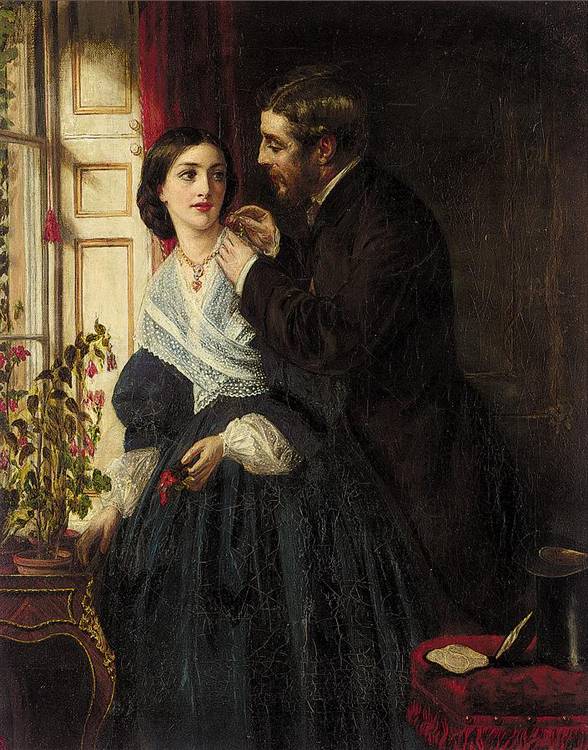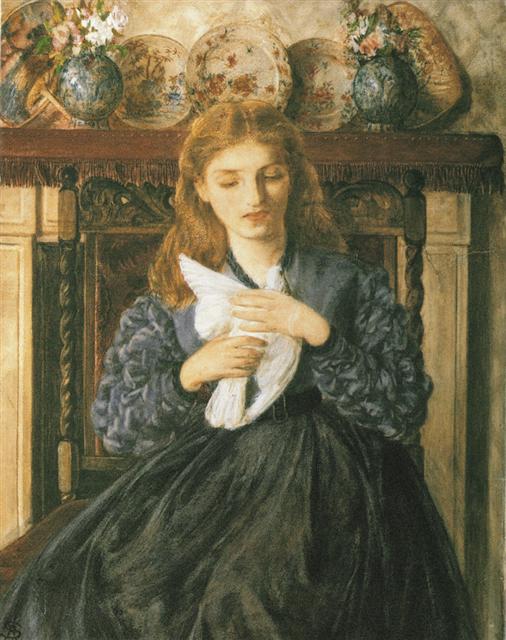Rebecca Solomon (1832-1886) hit the news in 2022. Her painting A Young Teacher was bought by Princeton University Art Museum, for over ten times its auction estimate. Subsequently an export bar has been placed on it 'on the grounds that its departure from the UK would be a misfortune because it was of outstanding significance for the study of women artists and Jewish art in 19th century Britain, as well as to the history of art and Empire.' Tate and the Museum of the Home clubbed together to raise the necessary funds and A Young Teacher has been on display ever since. The painting is now by far the best known of Solomon's small group of surviving works but in fact, it was not one of her more successful. It didn't sell when it was exhibited in 1861 and critics appeared unsure of the subject, confusing Jamaican-born model Fanny Eaton with an Indian ayah. It was not Solomon's major work of that year, when she chose to exhibit The Arrest of a Deserter at the Royal Academy and showed A Young Teacher at the less prestigious Henry Wallis' French Gallery. Nor is it even particularly representative of Solomon's work, employing a more Pre-Raphaelite emphasis on texture, pattern and drapery than many of her paintings.
Therein lies the problem with most discussion of Rebecca Solomon's work. She was a Jewish woman who managed to make a living as an artist in mid-Victorian London. But somehow those facts have been subsumed into two alternative narratives, one which revolves around her relationships with her brothers, and one which fixes her work within a Pre-Raphaelite context. Rebecca was one of eight children in the Solomon family, three of whom became successful artists. Her older brother, Abraham and her younger sibling, Simeon, both studied at the Royal Academy, although Rebecca herself was excluded and had to attend the much less prestigious Spitalfields School of Design. This clearly rankled and she was one of a group of women who campaigned to change Academy policy, resulting in the first female students being admitted in 1860.
As a single woman, Solomon made what was at the time the obvious decision to live and share studio space with her brothers, first Abraham until his early death in 1862 and then Simeon. And, as is the case with much literature on women artists, this has led to the implication that without those family connections she would have never had a career. That she is somehow diminished as an artist because she pursued the same career as other members of her family. Nothing could be further from the truth. Solomon earned her own living as drapery specialist John Everett Millais' studio. She had a wide circle of her own friends and correspondents, including Dante Gabriel Rossetti and George du Maurier. She was very active in promoting her own work. The likelihood is that she introduced Simeon to Pre-Raphaelitism rather than the other way round. The final and tragic irony is that far from helping her career, her brother effectively destroyed it. Her close association with Simeon meant that when he was prosecuted for indecency in 1873 Rebecca was somehow implicated in his 'debauchery'. Her career never recovered, she didn't exhibit after 1874, and we know very little about her life. The fact that her death, the result of a traffic accident, was linked to unsubstantiated rumours of alcoholism and substance abuse, shows just how detrimental to her reputation Simeon's arrest was. Perhaps most unjustly of all, he did continue to paint.
Rebecca Solomon's close association with Simeon, and her use of Fanny Eaton as a model both in A Young Teacher and in A Double Tie leads to the second problem with scholarship about her. She has been repeatedly described as a Pre-Raphaelite: she was included in Jan Marsh and Pamela Gerrish Nunn's 1999 Pre-Raphaelite Women Artists and the National Portrait Gallery's 2019 exhibition, Pre-Raphaelite Sisters. Most of the press coverage surrounding A Young Teacher refers to her as a Pre-Raphaelite, and whilst association with the movement has undoubtedly raised her profile today, it is also reductionist. The reality was that Solomon was canny market operator. She was well aware of the popularity of her older brother Abraham's narrative genre style, and judging by the range of her subjects she was always willing to produce what she thought the public wanted.
Thus we see Rebecca Solomon producing paintings based on history (The Fugitive Royalists or The Claim for Shelter (1862)), literature (Imogen from 'Cymbeline' (1865)) and contemporary talking points (The Story of Balaclava Wherein he Told of the Most Disastrous Chances (1855). We see her, clearly inspired by the success of her older brother's 'paired' genre scenes like Waiting for the Verdict (1857) and Not Guilty (The Acquittal) (1857,) produce a similar pairing: The Virtuous Undergraduate (1859) and The Dissolute Undergraduate (1859). We see her influenced by Pre-Raphaelite aestheticism with work like Primavera (1864), where narrative subject matter is replaced by a painting of mood and beauty. Whereas this variety is often portrayed as a lack of individuality, or, even worse, as a feminine lack of dedication and steadfast character, the reality is that it shows an artist attuned to market trends and willing to adapt to make commercially successful paintings.
Rebecca Solomon had a recognisable and very individual interest in representing those on the margins of society, and particularly to subtly underlining the experience of contemporary women. Most famously, her depiction of The Governess (1854), goes a stage further than Richard Redgrave's 1844 version in deliberately juxtaposing the dowdily dressed teacher with the pretty-in-pink young mother enjoying her piano playing and attentive husband, whilst her child is looked after by someone else. The governess, purely because of her social and financial status has lost the opportunity to have a husband or a child of her own. But through the close proximity of the protagonists, Solomon also suggests the careless disregard of the employers, and the invisibility of the woman in whom they are entrusting their son and heir.
Perhaps more subtly, in all her depictions of relations between the sexes, Solomon underlines the restrictive expectations placed on contemporary woman. In The Birthday Gift, the looming intrusiveness of the man belies the title, suggesting that the 'gift' comes at a potentially unacceptable price. The repeated use of red, the heaviness of the necklace and the juxtaposition between interior darkness and light, reinforce the positioning of the figures.
.jpg/532px-The_Young_Teacher_by_Rebecca_Solomon_(1861).jpg)






No comments:
Post a Comment